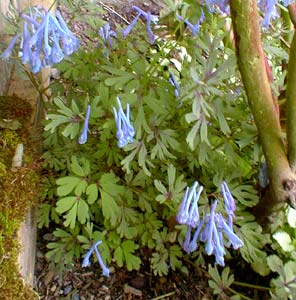 Purple Dragon Corydalis
Purple Dragon Corydalis
Puget Sound weather is perfect for Corydalis flexuosa, though it would be delicate in even slightly warmer areas. Several cultivars have become available over time, & we have the original 'Blue Panda,' plus this improved cultivar another of these, called 'Purple Leaf' a.k.a. 'Purple Dragon,' shown here in a May portrait at the foot of a Redtwig Dogwood.
Though it came with no promises of being summer-hardy, our 'Purple Leaf' in fact does not die back in summer, though 'Blue Panda' usually does become temporary thin & ragged about August. A detailed description of the habits of 'Blue Panda' vs 'Purple Leaf' show them to be a bit different, but how much of that is merely subtle differences in their different areas of the gardens is hard to say.
'Purple Leaf' was much slower than 'Blue Panda' at establishing a large spreading clump. Though seemingly less aggressive in spread, it is a stronger plant & continues blooming even through the hottest days of summer & well into autumn. It goes semi-dormant in winter without quite dying back all the way, whereas 'Blue Panda' briefly dies to the ground in winter, returning long before spring.
Though the behavior of these two varieties is quite different in our gardens, they are physically awfully close to the same. Appearance-wise, the purple tint on the leaves of 'Purple Dragon' is not overt, & the flowers are about the same rich shade of transluscent blue. In fact most C. flexuosa cultivars look very much alike.
Corydalis species have been studied for medicinal value. For American herbalists, a native Corydalis called "Dutchman's Britches" (because the flower looks like pants instead of fish) is the variety usually meant, but enough others have been investicated that it can be assumed Corydalis spp. in general share whatever active ingredient or value has been assigned to others.
Those species which grow in China, including C. flexuosa, have been included in the Chinese herbal pharmacological choices for pain relief. The corms or tubers contain alkaloids with narcotic effect not unlike opium, though considerably less powerful than in an opium poppy. Still, it is potentially psychotropic, & like so many bulbs can be toxic if eaten, inducing lethargy, faintness & vertigo.